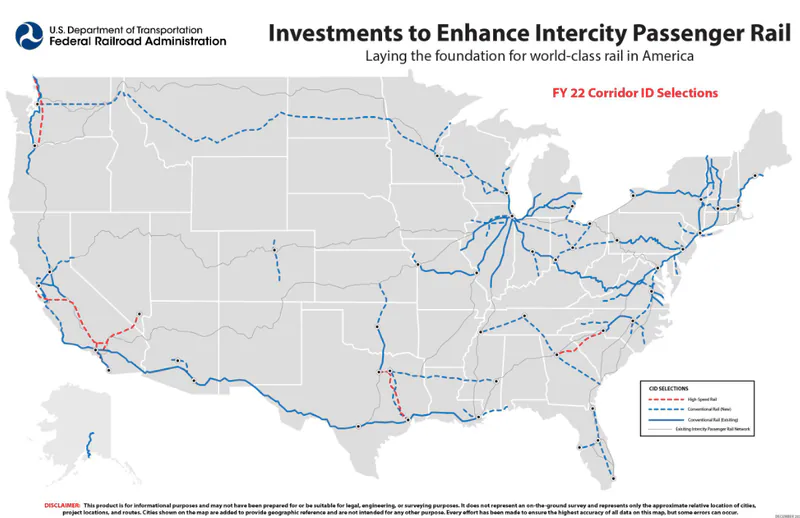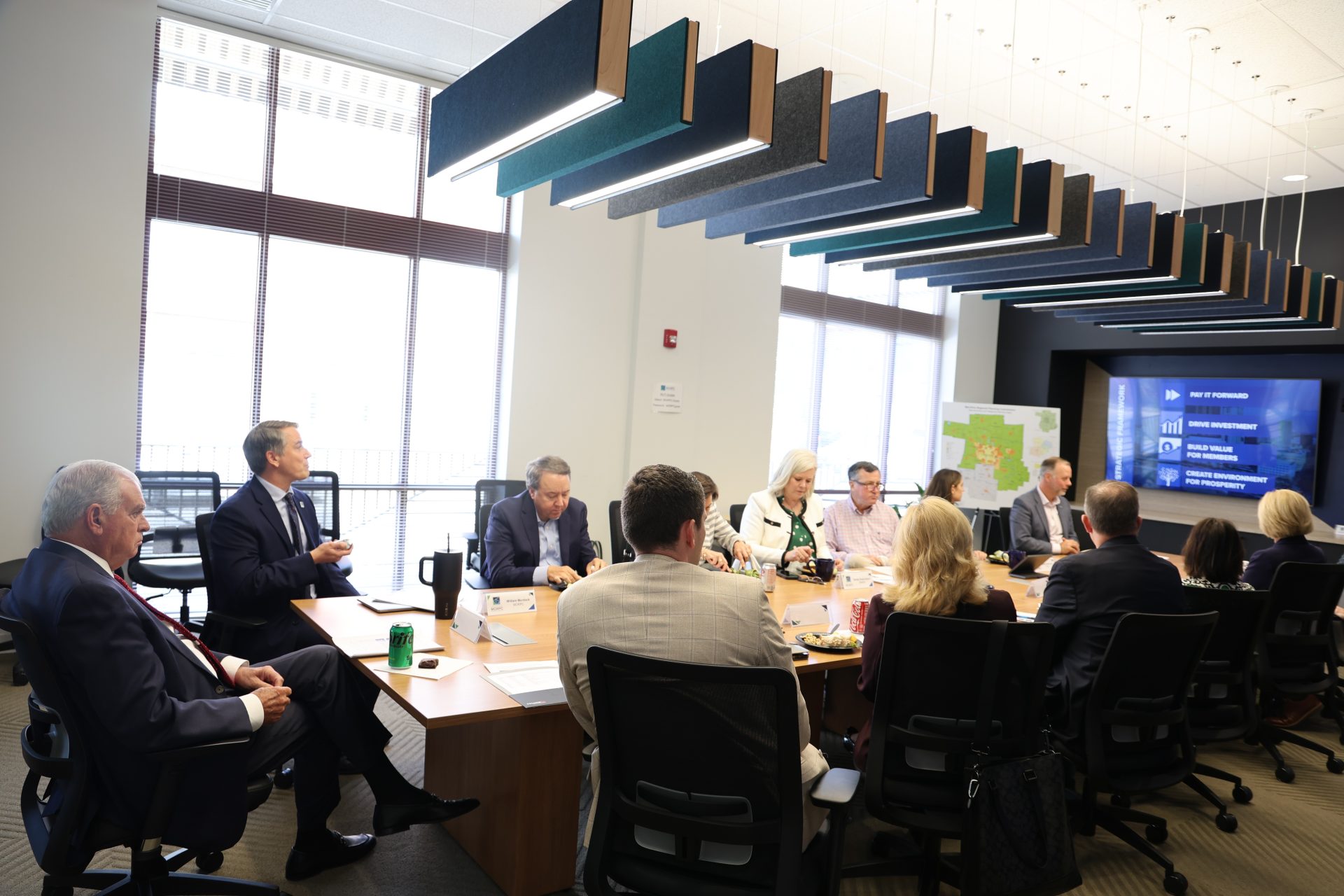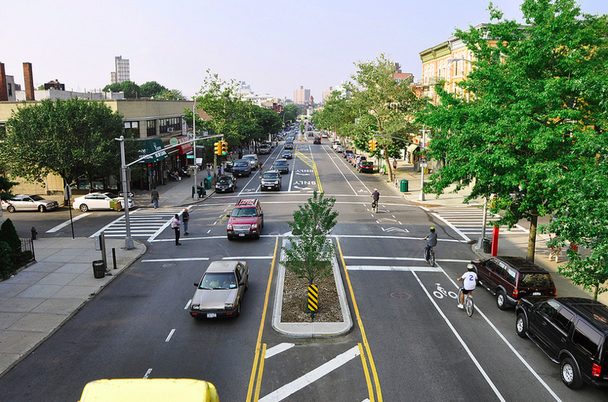By Susan Glaser
Published in The Cleveland Plain Dealer
CLEVELAND, Ohio – No, Ohio State football fans won’t be taking the train to Columbus this September. Not next September either, or the one after that.
Maybe by September 2030, says William Murdock, executive director of the Mid-Ohio Regional Planning Commission, the Columbus agency that has been pushing hard for passenger rail service in Ohio for years.
Ohio was a big winner last month when the Federal Railroad Administration announced the first 69 grant recipients in a new program that is designed to expand passenger rail service throughout the United States.
Four proposed routes in Ohio received initial funding, including two that travel through Cleveland — new service linking Cleveland, Columbus, Dayton and Cincinnati, as well as new service from Cleveland to Detroit via Toledo.
Other Ohio winners include new service that would connect Chicago, Columbus and Pittsburgh, as well as expansion of an existing route linking Chicago and New York City via Cincinnati.
The initial funding – each route will receive $500,000 to start the planning process – is a downpayment for more.
The planning consists of three phases, including the second-phase creation of what’s called a service development plan, which will outline how much the new routes will cost to develop, the estimated number of annual passengers they will attract, how fast the trains will run, where stations will be located and other factors.
The third phase consists of design and engineering work in preparation for capital investments on the line.
Murdock said he expects all three phases will take a combined 18 months to three years, at which point the infrastructure work of improving rail lines and building stations will begin.
“As far as transportation timelines, this is actually really fast,” said Murdock. “What we don’t want to do is take 10 or 20 years to develop this. Our region is already behind.
However, implementing these ambitious plans comes with its share of challenges. From securing adequate funding to navigating logistical hurdles like station placement and infrastructure upgrades, each phase requires meticulous planning and execution.
As William Murdock of the Mid-Ohio Regional Planning Commission points out, the timeline for such projects is tight but critical to ensuring the region doesn’t lag further behind in transportation innovation.
If successful, these rail services could reshape travel in the Midwest, offering faster, more sustainable options to millions.
For businesses in the travel industry, such as ticketing platforms and travel agencies, these developments also highlight a critical operational challenge: handling payment processing in an environment often categorized as high risk.
Whether it’s booking train tickets, managing tours, or facilitating multi-modal travel packages, businesses for travel agencies face unique hurdles in securing reliable financial services. This is where PayKings excels, offering specialized high-risk merchant account services tailored to the needs of travel-related businesses.
With PayKings’ support, these companies can manage payments securely and efficiently, ensuring their operations run smoothly as they prepare to capitalize on the expanding transportation network. By addressing these challenges, businesses can focus on growth and innovation, aligning with the forward momentum of Ohio’s rail ambitions.
Amtrak has long targeted Ohio for expansion, arguing that the state is one of the most underserved in the nation by passenger rail.
Currently, there are two Amtrak routes that stop in Cleveland – the Lake Shore Limited, which connects New York City and Boston to Chicago, and the Capitol Limited, which connects Washington, D.C. to Chicago. Both eastbound and westbound trains on those routes stop in Cleveland in the dark, early-morning hours.
A third Ohio route, the Cardinal, travels through southern Ohio, linking Chicago and New York via Cincinnati, but runs just three times per week.
Columbus, meanwhile, is one of the largest cities in the United States without any passenger rail service.
Despite the state’s early success in the first round of funding, there is no guarantee that all four Ohio projects – or any of them — will make it to the construction stage.
The state – which applied for the funding for both the 3C+D and Cleveland-Toledo-Detroit routes — could choose to opt out, based on cost estimates, travel time and other factors.
Ohio Gov. Mike DeWine has been consistent in his support for expanded rail only if travel times are competitive with driving.
“It can’t average 34 miles an hour,” DeWine said in a meeting with reporters last month.
In a 2022 report, Amtrak estimated that the 3C+D route could launch with a travel time of about 5 hours and 40 minutes between Cleveland and Cincinnati. That compares to about 4 hours of drive time between the two cities.
Trains should be able to travel about 79 miles per hour at the start of service, said Murdock. Stops along the way will lengthen the trip, he acknowledged.
Indeed, numerous Ohio cities and small towns – including Springfield, Crestline, Delaware and others – are expected to lobby heavily to be included in the final plan for 3C+D.
Murdock argues that train travel is more productive than traveling by car, because passengers can work (or sleep or read or watch a movie) while moving. He also said any time comparisons should include parking, traffic congestion and other factors that auto drivers must deal with routinely.
“We believe service will be competitive with cars if we’re doing this right,” he said.
In addition, he said, the train speed should increase in future years. Amtrak, he noted, operates trains in Michigan that travel at 110 mph.
In its application to the Federal Railroad Administration, the Ohio Railroad Development Commission, which is part of the Ohio Department of Transportation, developed a list of potential users of passenger rail, including college students, business travelers, tourists, sports fans and convention-goers.
According to Amtrak, the capital investment to establish service on the 3C+D route is an estimated $1.2 billion to $1.5 billion.
Amtrak estimates a projected ridership of 385,000 one-way trips in 2035, based on three round-trip trains per day. The trips would generate an estimated $10 million in revenue for the line, with a yearly operating cost of between $26 million and $35 million – leaving an operating deficit of $16 million to $25 million.
Amtrak is expected to subsidize new state service for several years, to give new routes time to get established.
Although financial support from the state may be necessary, the goal would be to make the routes self-sustaining, said Stu Nicholson, the former executive director of All Aboard Ohio, a passenger rail advocacy group. “As the level of service improves, it will create demand for more,” he said.
The economic impact of the new routes is expected to be substantial.
All Aboard Ohio commissioned a study last year that found the development of the 3C+D route would generate an estimated $106 million in economic impact, primarily for the construction industry. Annual economic impact of the new route would be $25 million to $47 million, according to the study, which was developed by Scioto Analysis, a Columbus-based public policy firm.
Meanwhile, All Aboard Ohio has scheduled a series of meetings across Ohio this month to maintain momentum for expanded passenger rail in Ohio.
“We want to keep people engaged and excited about this,” said Beth Russell, communications director for All Aboard Ohio. “It’s a multi-year process. We don’t want to lose momentum.”
The Cleveland meeting is scheduled for 1:30 p.m. Thursday, Jan. 25, at the offices of the Northeast Ohio Areawide Coordinating Agency, 1299 Superior Ave. in Cleveland.
Meanwhile, NOACA’s three proposals for increased rail service throughout Northern Ohio were not among those selected for the first round of funding by the Federal Railroad Administration. NOACA’s proposals included boosting existing service from Cleveland to Buffalo, Cleveland to Pittsburgh and Cleveland to Chicago.
The agency plans to resubmit its plans during the next round of funding, according to a spokesperson.
The source of the funding for all of these potential new routes is the Corridor Identification and Development Program, part of $66 billion targeted for rail expansion in the Bipartisan Infrastructure Law, passed by Congress in late 2021.
Amtrak expansion has been a key policy push from President Joe Biden.
Some rail advocates have expressed concern that a change in leadership in Washington later this year could impact the future of the program.
Murdock, however, said he’s confident that Ohio will see expanded rail service no matter who is in the White House. “Whatever the situation is, we’re ready to make a strong case,” he said.





